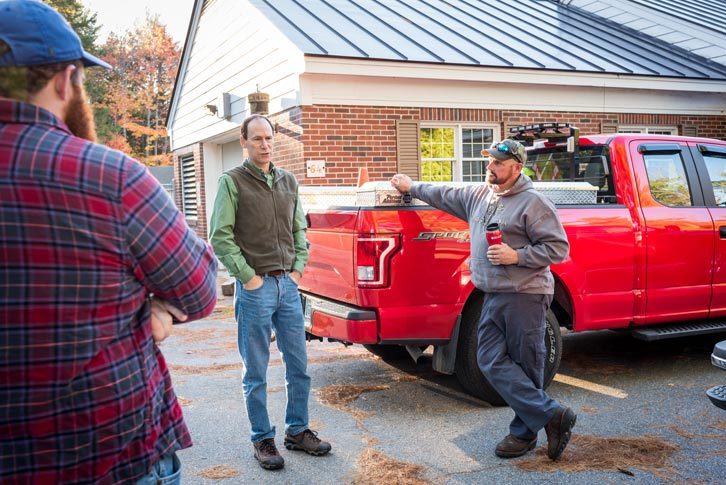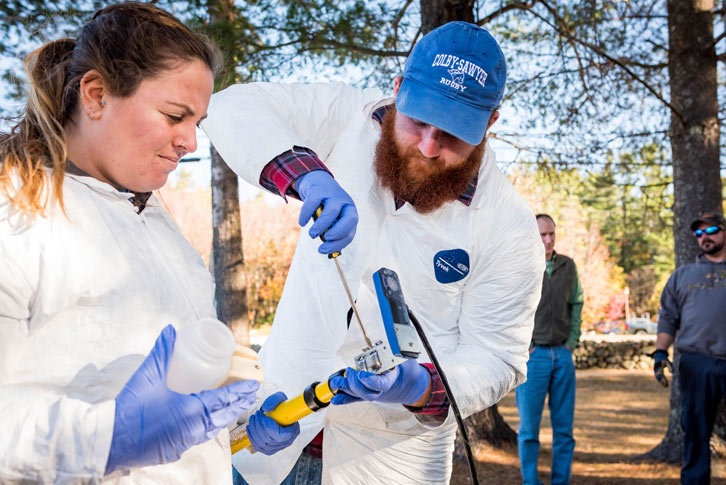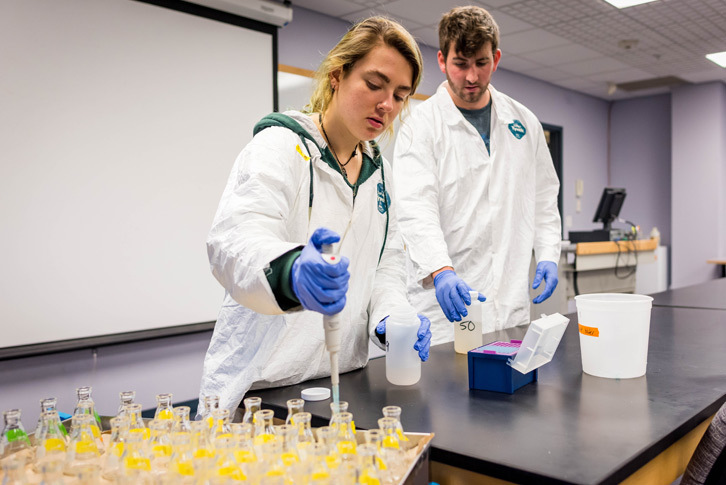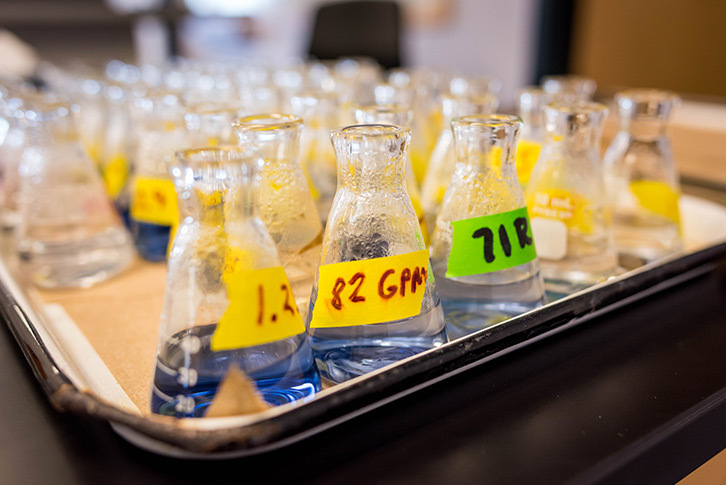Symbiosis describes a relationship between two or more organisms that live closely together, often for the benefit of both parties. From the microbes taking up residence in the human gut to the bumblebees that pollinate flowers on their search for nectar, life depends on—and is better—in partnership. The same holds true for research. Learning is most meaningful when applied to real-world scenarios, and the relationship between Colby-Sawyer College and its hometown of New London has allowed environmental students to collaborate with local stakeholders to solve community problems.
This year’s Community-Based Research Project course is partnering with community members to investigate the concentrations of phosphorus in the town’s wastewater. The 11 students in the yearlong class are collecting data, compiling information, conducting a survey and developing a public outreach plan to reduce the phosphorus input.
A graduation requirement for all environmental science and studies students, the course gives students the chance to apply their laboratory and analysis skills to a local environmental concern. Previous classes created a revitalization plan for the city of Franklin; developed conservation priorities for Ausbon Sargent Land Preservation Trust; and designed a landscape management plan for the campus. This time, the town of New London approached the college and asked for the students for their partnership.

Phosphorus is a chemical element essential for life—its one of the major building blocks of DNA and other critical cell structures. Too much phosphorus, however, poses a serious problem to aquatic ecosystems. In extreme amounts, it can trigger excessive algae growth, which in turn can deplete the water’s oxygen levels and block sunlight from reaching life forms under the surface. Some algae even produce toxins harmful to other organisms.
“In other words, too much phosphorus can disrupt the delicate balance of life,” explained Nicole Semeraro '18 from North Reading, Mass.
New London’s wastewater is processed at the Sunapee Wastewater Treatment Plant before being released into the Sugar River. In order to prevent nutrient pollution, the treatment center must take additional steps to remove the phosphorus. Sunapee charges New London for this service, which means taxpayers pay the price.
The class hopes its research can help the town save money while also protecting local water systems.
Another World Down There
On a brisk October morning, Professor of Environmental Studies Nick Baer, who co-teaches the course with Associate Professor of Environmental Studies Harvey Pine and lab manager Teriko McConnell, hopped into the driver’s of seat of Professor Pine’s truck while three students piled in after him. It was a Friday, which means it’s a sampling day.
When they reached the first site off County Road, Chris Roberts, a New London Public Works Department staff member who accompanies the class every Friday, removed the manhole cover—which weighs upwards of 100 pounds—and the students jumped into action.

Lowering a long pole into the sewer, Brandon Beaudry '19 of Woonsocket, R.I., collected a sample of the wastewater. Semeraro helped him sanitize the bottle by dunking it in a bucket filled with a bleach solution. Finally, Beaudry used a discharge probe to take a reading of the flow rate.
Ashleigh Wilson '19 of Quincy, Mass., watched as a computer connected to the probe calculated and recorded the velocity. The two measurements—the concentration of phosphorus and the flow rate—give the students the site’s phosphorus load at that point in time.
It’s unusual to see students in white coats carrying lab instruments in the center of New London. Pedestrians often ask what the students are doing.
“During my first sampling, a man came up to us, looked into the sewer and said, ‘It’s like another world down there,’” Semeraro said. “And I replied, ‘Yes, sir, it is.”

The students have identified 16 locations that will allow them to get a picture of phosphorus contributions from major business and residential areas without having to test every manhole in town.
Phosphorus is a common component in cleaning products, from dish and laundry detergent to body wash. The class hopes their samples will provide insight into where the phosphorus is coming from and how much each community in New London contributes.
“There are a lot of pieces,” Professor Baer said. “It’s like a whodunit or a CSI case, and it just takes a great deal of sampling to figure it out.”
It’s a lot of work, but the students have fun, too. Semeraro and Wilson teased Beaudry when he donned his lab coat — he somehow always gets stuck with the smallest one — and everyone laughed when Semeraro’s sample bottle caught a piece of toilet paper.
The group of students sampling rotates every week and the team that collects the data the fastest earns bragging rights. The record is two hours and eight minutes.

The following week students in the lab tested the samples. Grace Ledgard '19 of Newton, Mass., and William Astle '19 of Warner, N.H., used a spectrophotometer to send a known amount of light through the samples. A sensor on the other side records how much light passed through the solution, and therefore how much phosphorus is present.
The students are following the New Hampshire Department of Environmental Services’ method for determining total phosphorus. Teriko MacConnell, lab manager for the Lake Sunapee Protective Association’s satellite laboratory at the college, assists the students in their chemical analysis.
“When analyzing samples in the lab, we have to follow specific procedures and if any data is outside of our margin of error, we have to find where we went wrong and fix the issue,” said Jordan O’Brien '19 of Townsend, Mass. “Understanding how to deal with problems in the field or lab can only be learned by experience.”

While it is too early to draw any conclusions, the students have made a few surprising discoveries. For example, students conducted outside research that suggests phosphorus in urine is a bigger contributor than previously suspected.
The class is modifying aspects of their project as they go, and their preliminary results will inform what recommendations they make to the town in May.
Partnership Gets Results
In addition to the field sampling and lab work, the students formed subgroups to accomplish some of their course’s larger tasks.
The scope group determined the project’s focus and drafted a statement of purpose, which was included in their first report to the town. Another group is working on making a GIS map of the phosphorus hotspots and overlying that on a preexisting tax map. A public relations group has contacted various publications to introduce the community to their project. Three students even spoke about their research on WNTK-FM.
The students also hold themselves accountable. In addition to creating a quality control manual and conducting a literature review, they meet with Public Works Director Richard Lee often and have presented monthly reports to the Board of Selectmen.

“Working with the students has been great,” said Town Manager Kimberly Hallquist. “They conduct themselves in a professional manner and are taking this project seriously.”
The students gave a midyear presentation of their research on Dec. 7 in the Ivey Science Center. The public turned out in full support to learn about ways they can limit their use of cleaning products containing phosphorus.
Next semester, the students will continue to take samples every week. They will also send out a survey to homeowners and businesses to determine what products they use and in what quantity.
“We hope to get a high response rate,” said Semeraro. “The town’s people would be helping us, and we can, in turn, use their responses to help them."